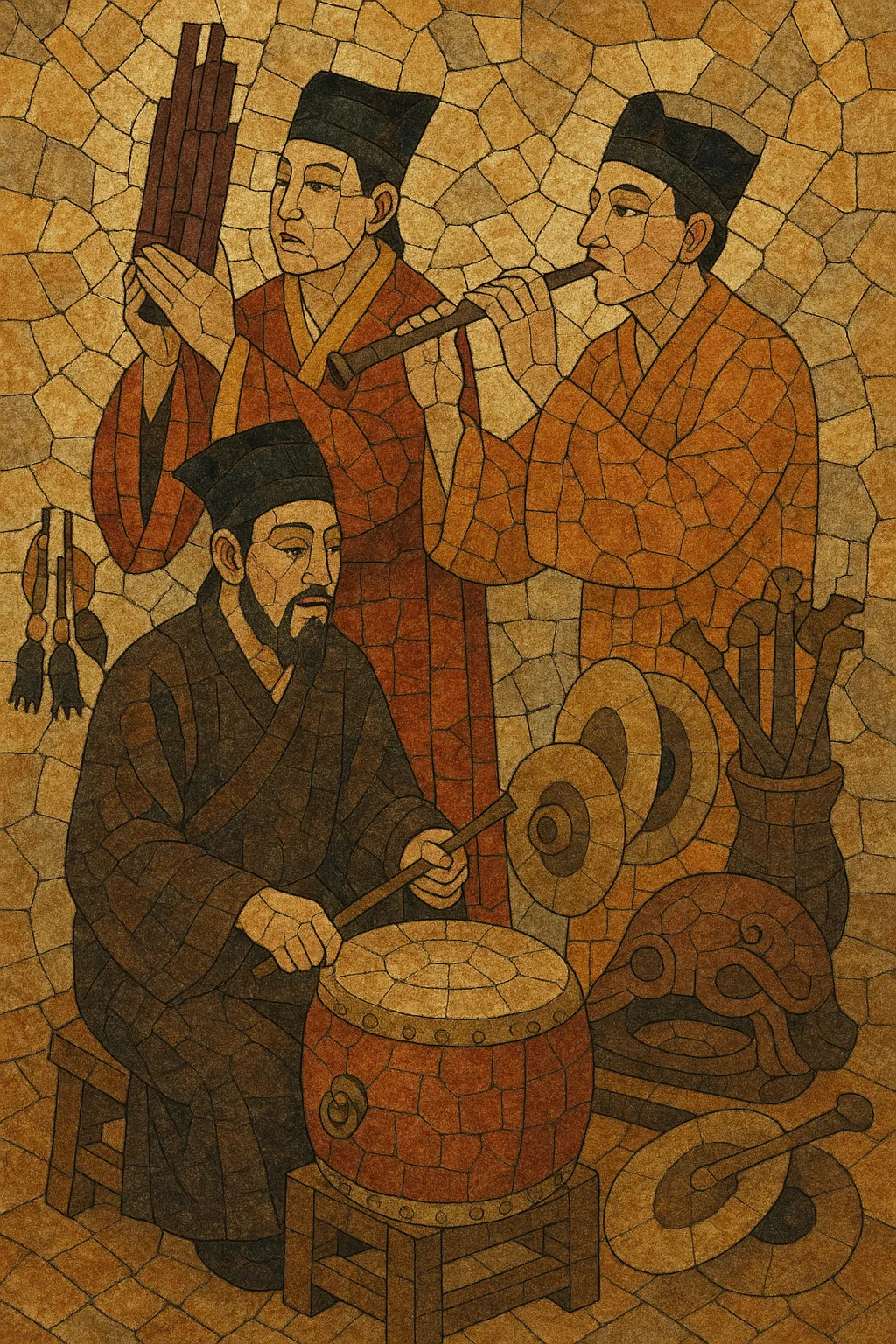Taoist ritual music is the liturgical sound-world of Daoist (Taoist) religion, accompanying rites of invocation, purification, offering, exorcism, and thanksgiving. It combines vocal chant, intoned scripture, and heterophonic instrumental ensembles to shape sacred time and space within temples and processions.
Core timbres come from the sheng (mouth organ), guanzi (double-reed), dizi (flute), and occasional suona (shawm) for outdoor or processional moments, supported by a ritual percussion battery: frame and barrel drums, hand gongs, cymbals, clappers, the wooden fish (muyu), and stone or bronze chimes (qing/zhong). Melodies draw on Chinese pentatonic and heptatonic modal practice, are transmitted in gongche (solmization) notation and oral lineage, and are organized into suites that align with the stages of the liturgy.
Taoist ritual music emerged from ancient Chinese court and temple practices, drawing on pre-Qin ritual sound culture and early Han-era Daoist movements. By the Eastern Han and Six Dynasties, Daoist liturgy (keyi) was developing fixed roles for chant and instruments to support petitions, exorcisms, and scripture recitation.
During the Tang and Song dynasties, Daoism enjoyed imperial patronage that helped formalize ceremonial repertoires. Court ritual music (yayue) aesthetics and notational habits intersected with Daoist temple practice, while gongche solmization aided transmission. Distinct chant types, processional pieces, and suite structures became widely shared, even as local dialects and styles diversified.
From the Ming through the Qing, liturgical music flourished within two major Daoist traditions: Quanzhen (monastic) and Zhengyi (ritual masters). Temple ensembles (‘sheng-guan’ bands) standardized instrumental roles; vocal chant linked to canonical texts (e.g., Daodejing, Lingbao scriptures). Regional idioms (North China sheng-guan, Jiangnan temple music, Fujian/Taiwan temple traditions) enriched the corpus.
The 20th century brought disruption and later revival. After mid-century interruptions on the mainland, the reform era and heritage initiatives supported reconstruction of temple ensembles and publication/recording projects. In Taiwan, Hong Kong, and Southeast Asian Chinese communities, lineages remained particularly active, with festivals and processions sustaining performance. Today, fieldwork, conservatory collaborations, and Daoist associations help safeguard and disseminate this living liturgical tradition.
Use a sheng-guan (wind-and-reed) core: sheng (mouth organ), guanzi (double-reed), dizi (transverse flute); add suona for outdoor/processional brightness. Support with percussion: tanggu/ban drums, small and large gongs (nao, bo), cymbals, clappers (ban/paiban), wooden fish (muyu), and stone/bronze chimes (qing/zhong).
Compose in Chinese pentatonic/heptatonic modes with characteristic final/reciting tones. Favor heterophony: each instrument ornaments the same melody differently. Use steady tones and graceful turns for indoor rites; more piercing, martial ornaments for exorcistic or processional sections.
Alternate free-rhythm chant (recitation) with metered sections in 2/4 or 4/4. Organize pieces into suites that match liturgical phases: purification/opening, invitations, offerings, circumambulations, send-offs. Employ tempo arches (slow–medium–slow) and cadential drum cues to signal transitions.
Set canonical Daoist texts (e.g., Daodejing excerpts, petitions/‘zhang’, Lingbao/Quanzhen hymns). Use responsorial patterns between lead cantor and chorus; maintain clear diction and controlled nasal resonance typical of temple chant. Keep melodic ranges moderate to preserve solemnity.
Sketch melodies in gongche solmization for reference, but rely on oral transmission and memorized cueing by percussion leaders. Indicate sectional cues with drum patterns and gong strokes rather than Western barlines.
For concert settings, keep core instrumentation and heterophony intact; program contrasting indoor (quiet, contemplative) and outdoor (bright, processional) pieces. Avoid heavy harmony—coloristic drones and parallel ornaments are more idiomatic than chordal writing.


